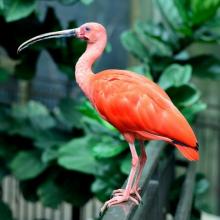Eudocimus ruber

Conservation Status:
Least Concern on the IUCN Red List. The Scarlet Ibis at Bird Kingdom are part of an AZA Species Survival Plan (SSP)
Range:
South America and the islands of the Caribbean
Habitat:
Wetlands and other marshy habitats
Ibises eat insects, crustaceans, fish, and soft fruit. They get their color from a carotenoid pigment found in shrimp and other red shellfish. Adult Scarlet Ibises are a solid orange/pinkish coral color, except for black wing tips.
Sexual maturity is reached around 4-5 years old. The mating pair will construct a nest of loose sticks. For safety, they build their nests in trees above the water and often use islands where the chicks will be less in danger from predators. Juveniles are dull, grayish black and start getting their scarlet feathers once they are around a year old.
Although they spend most of their time on the ground or wading through water, they are strong flyers and are easily capable of long-distance flight. Their long, thin toes help them easily walk through the water. Ibises help control insect pests. They are very valuable to farmers, but due to agricultural pesticide use, they are becoming locally endangered in many locations.
Scarlet Ibises are social and live in flocks of 30 or more birds. They will often nest close to other pairs in the same tree. For protection, Ibises will flock together with their own species or other shorebirds.
